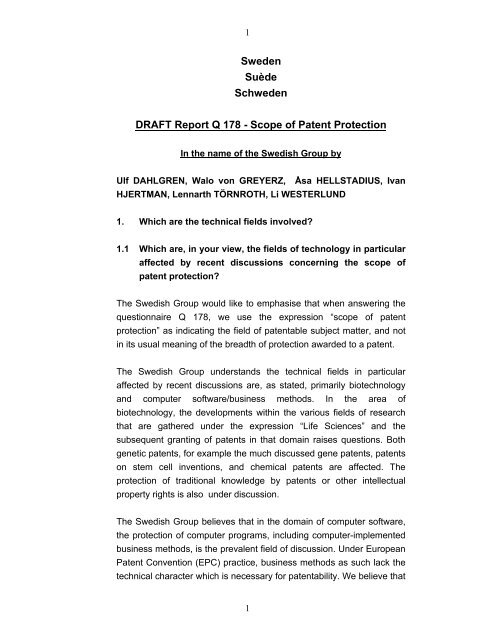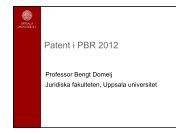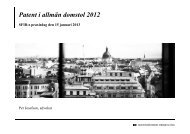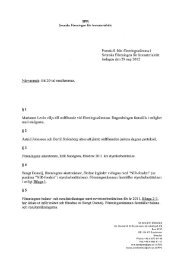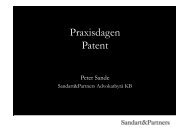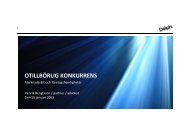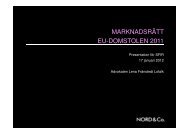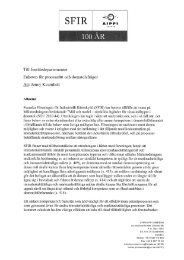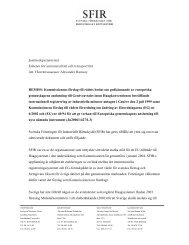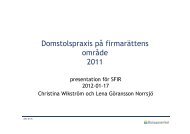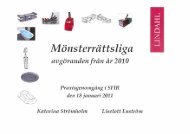Q178 draft report.pdf - SFIR
Q178 draft report.pdf - SFIR
Q178 draft report.pdf - SFIR
You also want an ePaper? Increase the reach of your titles
YUMPU automatically turns print PDFs into web optimized ePapers that Google loves.
1<br />
Sweden<br />
Suède<br />
Schweden<br />
DRAFT Report Q 178 - Scope of Patent Protection<br />
In the name of the Swedish Group by<br />
Ulf DAHLGREN, Walo von GREYERZ, Åsa HELLSTADIUS, Ivan<br />
HJERTMAN, Lennarth TÖRNROTH, Li WESTERLUND<br />
1. Which are the technical fields involved?<br />
1.1 Which are, in your view, the fields of technology in particular<br />
affected by recent discussions concerning the scope of<br />
patent protection?<br />
The Swedish Group would like to emphasise that when answering the<br />
questionnaire Q 178, we use the expression “scope of patent<br />
protection” as indicating the field of patentable subject matter, and not<br />
in its usual meaning of the breadth of protection awarded to a patent.<br />
The Swedish Group understands the technical fields in particular<br />
affected by recent discussions are, as stated, primarily biotechnology<br />
and computer software/business methods. In the area of<br />
biotechnology, the developments within the various fields of research<br />
that are gathered under the expression “Life Sciences” and the<br />
subsequent granting of patents in that domain raises questions. Both<br />
genetic patents, for example the much discussed gene patents, patents<br />
on stem cell inventions, and chemical patents are affected. The<br />
protection of traditional knowledge by patents or other intellectual<br />
property rights is also under discussion.<br />
The Swedish Group believes that in the domain of computer software,<br />
the protection of computer programs, including computer-implemented<br />
business methods, is the prevalent field of discussion. Under European<br />
Patent Convention (EPC) practice, business methods as such lack the<br />
technical character which is necessary for patentability. We believe that<br />
1
2<br />
the patent system with the current practice under the EPC fulfils the<br />
existing needs for protection in this domain.<br />
The Swedish Group believes that the value of the protection granted for<br />
inventions in the domain of computer programs/business methods is<br />
hard to estimate, which may cause future problems. The granting of<br />
and subsequent enforcement of rights lead to questions of proper<br />
scope and breadth of protection, and whether or not the legal system<br />
can deal with this in a proper way.<br />
1.2 What makes this field/these fields of technology special<br />
compared to other fields of technology in the context of this<br />
discussion?<br />
The field of biotechnology can be technically more complicated than<br />
others. In court proceedings, a high level of technical knowledge is<br />
needed in order to reach a proper interpretation. The rapid<br />
developments in research and the increasing patenting makes it hard<br />
for legal experts to overlook the situation in a longer perspective, and to<br />
establish a proper balance of protection for inventions in this domain.<br />
The field of business methods, on the other hand, is said by some to be<br />
characterised by the fact that the inventions are not so much the results<br />
of research and development, but rather quite simple innovations.<br />
Within the field of computer programs, the technique is not that<br />
complicated, compared to, for example, biotechnology patents. Rather<br />
it is the language in the technical descriptions that are sometimes<br />
unfamiliar for others than experts in the field.<br />
In the opinion of the Swedish Group, the usual criteria for determining<br />
questions on patentability and breadth of patent rights have been<br />
difficult to implement into the new areas of technology. The<br />
patentability criteria may not have been implemented and interpreted<br />
strict enough in the new domains, resulting in lowered thresholds for<br />
patent protection.<br />
Ethics and moral issues in biotech research is present at the legal<br />
level. Inventions whose exploitation is contrary to ordre public or<br />
2
3<br />
morality may not be patented under the EPC. However, ethical<br />
considerations do – and should – play a larger role outside the narrow<br />
field of patent issues. Nevertheless, many feel that it is wrong to allow<br />
for exclusive rights to biological material of human origin. For instance,<br />
the debate concerning patenting of human genes is ongoing in<br />
Sweden, involving political, legal and ethical experts, but consensus is<br />
not easily reached.<br />
The Swedish Group is of the opinion that there is a lack of knowledge<br />
and misunderstandings with the public on what exactly a patent right is.<br />
These misunderstandings could in the long run pose a threat to the<br />
existence of patent rights in biotechnology, as public perceptions<br />
influences the political decisions.<br />
The exceptions from patentability under the EPC are not clear. The<br />
case law of the Boards of Appeal at the European Patent Office (EPO)<br />
shows that the legal rules are difficult to implement in practice. This is<br />
evident concerning the exceptions for plant varieties and inventions<br />
contrary to ordre public and morality. The lack of clarity as to what<br />
should be patentable and not causes problems of interpretation. See<br />
supra question 2.3.<br />
2. Practice of the patent granting authorities<br />
2.1 What is the definition of patentable subject matter in your<br />
jurisdiction?<br />
European patent law is harmonized as to the granting of patents.<br />
Patent protection in Sweden is regulated in the Swedish Patents Act<br />
and the Patents Decree. Sweden, as a member of the EPC, has<br />
implemented the convention’s requirements on patentability in the<br />
Swedish legislation. Thus, the case law of the EPO Boards of Appeal<br />
serves as a standard for interpreting Swedish law. The EU Directive<br />
98/44 on the protection of biotechnological inventions (The Biotech<br />
Directive) aims to establish some clarifications in the field of<br />
biotechnology patents. The work of implementation of the Directive in<br />
Swedish legislation is currently taking place (September 2003).<br />
3
4<br />
The harmonisation of European patent law has lead to a situation<br />
where the definition of patentable subject matter does not differ<br />
between the European countries. The requirements in the EPC are<br />
prevalent. The object of patent protection is an invention. An invention<br />
must have technical character, i.e. present a technical solution to a<br />
problem.<br />
Do different definitions apply in various fields of technology?<br />
If so, what are the differences?<br />
The Swedish Group understands that there is no difference as to the<br />
patentabillity requirements between various fields of technology.<br />
However, the distinction between inventions and discoveries has been<br />
questioned within the area of biotechnology, as many of the inventions<br />
patented contains biological material existing in nature. It is therefore<br />
stated in Article 3.2 of the Directive that “biological material which is<br />
isolated from its natural environment or produced by means of a<br />
technical process may be the subject of an invention even if it<br />
previously occurred in nature”. Thus, natural biological material that is<br />
either “isolated” or “produced by the means of a technical process” may<br />
fulfil the basic criterion of technical character.<br />
In theory, difference definitions are not applied between various fields<br />
of technology. However, in the opinion of the Swedish Group, there is a<br />
practical difference between biotechnology patents and patents in other<br />
fields. We believe that the application of the patentability criteria (i.e.<br />
inventive step) in biotechnology patenting has not been as strict as<br />
required, compared to traditional fields of inventions.<br />
2.2 What are exemptions/exceptions from patentability?<br />
As indicated supra, the exemptions from patentability in Swedish law<br />
are the same as in the EPC.<br />
Some subject matter is never regarded as inventions according to<br />
Swedish and European patent law. Discoveries, scientific theories and<br />
mathematical methods, aesthetic creations, schemes, rules and<br />
methods for performing mental acts, playing games or doing business,<br />
programs for computers, and presentations of information are not<br />
4
5<br />
patentable subject matter. A common characteristic of this subject<br />
matter is that it is not perceived to have technical character and can<br />
therefore not be regarded as inventions from a patent law perspective.<br />
Hence, it is not patentable subject matter as such. Other subject matter<br />
may be regarded as inventions and fulfil the necessary patentability<br />
criteria, but nevertheless be expressly excepted from patentability on<br />
other grounds. The following are the exceptions found in EPC and in<br />
Swedish law:<br />
* Methods for treatment of the human or animal body by surgery or<br />
therapy and diagnostic methods. This exclusion does not apply to<br />
products, in particular substances or compositions, for use of any of<br />
these methods.<br />
* Inventions whose commercial exploitation would be contrary to ordre<br />
public or morality; however, exploitation shall not be deemed to be so<br />
contrary merely because it is prohibited by law or regulation.<br />
* Plant or animal varieties.<br />
* Essentially biological processes for the production of plants of<br />
animals.<br />
2.3 What is the reasoning behind those exemptions/exceptions?<br />
The Swedish Group believes that most of the exemptions have policy<br />
grounds, and can be seen in an historical perspective.<br />
* Methods for treatment of the human or animal body by surgery or<br />
therapy and diagnostic methods.<br />
These methods are excluded from patentability for policy reasons. It<br />
has been regarded as unethical that medical or veterinarian personnel<br />
should be affected by the effects of the patent system when carrying<br />
out such methods as part of treatments of human or animals.<br />
* Inventions whose commercial exploitation would be contrary to ordre<br />
public or morality; however, exploitation shall not be deemed to be so<br />
contrary merely because it is prohibited by law or regulation.<br />
5
6<br />
The Swedish Group believes that the reason behind this exemption is<br />
the idea that the ethical and moral principles recognised of the<br />
countries in Europe should be prevalent and supplement the standard<br />
legal examinations in patent law. The provision is only limited to<br />
inventions of such a nature that they cannot at all be used in a moral or<br />
legal way. Within the field of biotechnology, it has been emphasised<br />
that this rule should be interpreted as to protect human, animal or plant<br />
life, for example to prevent the patenting of processes whose use<br />
would offend against human dignity.<br />
* Plant or animal varieties.<br />
* Essentially biological processes for the production of plants of<br />
animals.<br />
The Swedish Group understands that the exclusion of plant and animal<br />
varieties as well as essentially biological processes for the production<br />
of plants and animals from patentability originates from the historical<br />
division between macro- and microbiology in patent law, and the<br />
development of a separate sui generis protection system for plant<br />
varieties as products of traditional breeding processes (The Plant<br />
Variety Protection System). At the time of enactment of the EPC, a<br />
distinction between macro- and microbiology was quite natural.<br />
Microbiological processes such as fermentation had been used in<br />
industry for a long time, and the knowledge of microbiological<br />
substances such as for example antibiotics was nothing new. Plants<br />
and animals were traditionally bred by crossing and selection.<br />
The Swedish Group believes that the advent of biotechnology research<br />
has changed the prerequisites for this exclusion. Biotechnology<br />
processes are from a patent law perspective regarded as technical,<br />
and thereby possible to patent, notwithstanding the fact that naturally<br />
occurring material and processes are being used. Thus, the distinction<br />
between macro- and microbiology is no longer upheld, resulting in<br />
historical exclusions with no real basis in a modern patent system.<br />
3. What is the effect of this definition on activities concerning<br />
patent protection?<br />
6
7<br />
3.1 Is the scope of protection sufficient or does it lack<br />
opportunities for further protection? This includes economic<br />
aspects for the users as well as for the public in general<br />
regarding various technologies.<br />
In the opinion of the Swedish Group, the patent system is flexible<br />
enough to operate foreseeable needs for further protection, i.e.,<br />
providing patents to inventions that may be developed in the future<br />
within existing or new fields of technology.<br />
The Swedish Group does not believe that the field of patentable subject<br />
matter is overly broad, provided that the patentability criteria are strictly<br />
applied and national courts interpret the claims consistently to<br />
commensurate with the disclosure and not including prior art.<br />
In Sweden, the Group believes the balance between protecting the<br />
inventor without impeding the technical development, e.g. freedom to<br />
operate, to be appropriate.<br />
3.2 If the scope of protection is not sufficient, how does this<br />
affect the users’ policy on patenting? Does this also have an<br />
impact on research policy?<br />
As indicated supra, the Swedish Group believes the balance for patent<br />
protection with respect to patentable subject matter to be appropriate.<br />
3.3 What are obstacles from political or social sources outside<br />
the purely legal field which play a role in research and<br />
patenting?<br />
With respect to, in particular, life sciences, the Swedish Group believes<br />
that the possibility for patent protection is necessary to foster research<br />
and development by providing return for large investments.<br />
That being said, public perceptions of patenting, specifically in the<br />
biotech field with issues such as gene patents, receive unfavorable<br />
response. Also within the research community itself, specifically from<br />
researchers conducting much of the basic research at universities and<br />
7
8<br />
other public institutions, there may be resistance towards accepting the<br />
patent obstacles regarding research tools to freedom to operate.<br />
In Sweden, the researchers themselves still principally own their<br />
inventions conceived at public universities and other institutions with<br />
public funding. Whether it be a favorable or unfavorable situation for<br />
society is debatable. On the one hand it may arguably promote the<br />
entrepreneurial aspect of the patent system. On the other hand it may<br />
delay the release of new knowledge because of the secrecy<br />
requirements in the early stages of patent processes. The Swedish<br />
Group believes, however, that the same principal issues be present if<br />
universities and other public institutions would instead own the<br />
inventions.<br />
3.4 How should new kinds or categories of inventions be<br />
treated? Should there be an enlargement of patent<br />
protection? If so, what are the reasons?<br />
In the opinion of the Swedish Group, new kind of inventions and<br />
categories of inventions should be evaluated within the framework of<br />
the current patent system and that the traditional patentability criteria<br />
be applied. Hence, if a new invention or category of inventions possess<br />
technical character and is novel, if it is sufficiently disclosed and have<br />
inventive step it should be granted a patent if it show industrial<br />
applicability. The Swedish Group believes, however, that for new<br />
inventions and categories of inventions it is important to still strictly<br />
apply, for example, the criteria of inventive step and sufficient<br />
disclosure.<br />
3.5 If you find the field of patentable subject matter too wide,<br />
how should it be limited? What would be the reasons for<br />
such a limitation? What do you see as the positive effects of<br />
such a limitation?<br />
As set forth supra, the Swedish Group believes the balance to be<br />
appropriate regarding the field of patentable subject matter. The<br />
Swedish Group emphasizes again that it is the strict application of the<br />
traditional patentability criteria that should be the focus.<br />
8
9<br />
4. Further points of discussion<br />
4.1 Which upcoming problems do you see specifically as a<br />
result of a change of the scope of patent protection<br />
regarding the requirements for patentability, in particular<br />
novelty and inventive step?<br />
We understand the question as referring to possible problems if<br />
extending patentable subject matter. Given that the European patent<br />
system for patentability has the requirement of technical character,<br />
which also seems to be applied by the EPO and national courts, the<br />
Swedish Group believes that the traditional patentability requirements<br />
be adequate to control any extension of patentable subject matter. This<br />
being said, The Swedish Group identifies the importance of a strict<br />
application of the patentability criteria, specifically inventive step and<br />
sufficient disclosure to commensurate with the scope of the granted<br />
patent claim.<br />
Because novelty is but one patentability requirement and the initial one<br />
to meet, the Swedish Group does not believe that novelty is an issue. If<br />
the invention was not in the prior art, i.e., every element of the claim, it<br />
is and should of course be novel. The relevant threshold should be<br />
inventive step, whose strict application will ensure that only inventions<br />
having inventive merit will be granted a patent and, thus, allowed<br />
patent protection. In addition, specifically regarding certain fields such<br />
as, for example, the biotech field, the Swedish Group perceives that the<br />
requirement of sufficient disclosure should be applied so that granted<br />
claims commensurate with the disclosure and, hence, with the<br />
protection granted to the inventor.<br />
4.2 What are specific problems of the granting proceedings<br />
(search, examination) if the scope of patent protection is<br />
enlarged?<br />
Conducting relevant searches can pose a problem if a technical field is<br />
in its initial stage for the obvious reason that there will not be many<br />
references published and, thus, be searchable. Another problem can<br />
be that the Examiners lack the basic scientific knowledge within a new<br />
area and, therefore, will not know how to search for and evaluate<br />
9
10<br />
relevant references. The same concern of Examiner’s relevant<br />
knowledge of course applies to the application of the traditional<br />
patentability criteria to a field of technology not previously examined for<br />
patentability and which is not altogether researched.<br />
4.3 What do you see as possible solutions for these problems?<br />
Would further harmonization of the laws help to solve such<br />
problems and, if so, in which way?<br />
Sweden follows the EPO case law and, thus, the granting and validity<br />
aspects seem to be harmonized from a European perspective.<br />
Therefore, it is not a harmonization of patentability requirement such as<br />
that of inventive step that is an issue, but, if at all, it is the stringency of<br />
the application of, for example, inventive step at the EPO that may be a<br />
concern.<br />
In this context, the Swedish Group would like to suggest that further<br />
study be made on the effects which may result from the manner in<br />
which the test for non-obviousness on basis of a combination of prior<br />
art references is regulated in the USPTO, in the EPO and in the JPO.<br />
Citation by a USPTO Examiner of a combination of prior art references<br />
requires the Examiner to show the teaching or motivation to combine<br />
these cited prior art references. This practice should be compared with<br />
the corresponding rules in the examination procedures in the EPO and<br />
in the JPO, in order to establish possible different effects on the<br />
breadth of granted claims, for example in the biotechnology area. The<br />
Swedish Group believes that a harmonization of the granting procedure<br />
is desirable, including harmonization of the concepts non-obviousness<br />
and inventive step.<br />
Harmonization of infringement doctrines can help solving possible<br />
problems regarding breadth of protection allowed to patentable subject<br />
matter. Especially in situations when the patentee is granted the same<br />
set of claims and specification in each designated member state under<br />
the EPO-route and, therefore, is unable to tailor the claims to a specific<br />
doctrine.<br />
Regarding the search and examination stage, it is the opinion of the<br />
Swedish Group that such problems mainly concern quality system<br />
10
11<br />
issues. Further developments of documentation systems and sharing of<br />
examination results between patent offices can therefore minimize<br />
problems of this kind. Relevant training and hiring of specialists in the<br />
various fields of examination are fundamental.<br />
Summary<br />
The technical fields involved are primarily biotechnology and computer<br />
software/business methods. Also protection of traditional knowledge is<br />
under discussion.<br />
The Swedish/EPC patent system is considered to be appropriately<br />
balanced, and flexible enough to operate foreseeable needs for further<br />
protection within existing or new fields of technology.<br />
Strict application of the patentability criteria, specifically inventive step<br />
and sufficient disclosure, is necessary to commensurate with the scope<br />
of granted claims.<br />
Further development of quality system issues, documentation systems,<br />
sharing of examination results between patent offices, training and<br />
hiring of examination specialists, and harmonization of infringement<br />
doctrines are examples of areas for further study.<br />
11


